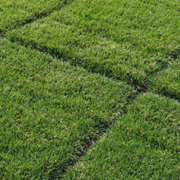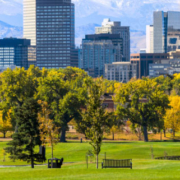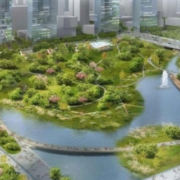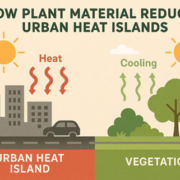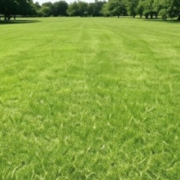Green Spaces are Cool (Spaces)
Summer temperatures in the United States have been getting hotter since 1970 with city temperatures increasing more quickly than adjacent rural areas. And since 80% of the U.S. population lives in cities, this trend affects the majority of Americans (Climate Central, 2014). Well-planned, climate-resilient landscapes not only provide aesthetic and recreational benefits but can also play a crucial role in cooling urban/suburban environments, mitigating the effects of increasing temperatures, and the associated effects on human health.
The elevated temperatures that urban areas experience is due to the elevated “urban heat island” (UHI) effect. The UHI effect occurs because of the density of impervious surfaces in urban areas, such as asphalt and concrete, which absorb and retain heat. In contrast to UHI, vegetated, localized areas in cities that are cooler are sometimes referred to as “park cool islands” and these areas offer a solution to the increasing challenges of the UHI effect (Shashua-Bar et al., 2009).
Research Highlights
- Urban heat islands occur because the density of asphalt and concrete helps them absorb and retain heat.
- Vegetation cools air temperatures through shading, evaporation, and transpiration.
- Trees intercept solar radiation and reflect both short and long wave radiation from structures and the ground.
How do Landscape Plants Cool the Environment?
Landscapes and plants cool the environment through several biological and physiological processes and these processes are, in turn, effected by adjacent buildings, sidewalks, and streets and the complex interactions between them. Even in a single, discreet location, temperatures can vary widely from the ground level upward through the urban canopy (Erell and Williamson, 2006).
Shading, Evaporation, and Transpiration
Vegetation cools air temperatures through shading that reduces surface temperatures, but also through the processes of evaporation and transpiration. The relative importance of evaporation and transpiration, though, varies with the local climate, the characteristics of the plants, and plant’s responses to the surrounding built environment (McPherson et al., 1994).
The landscape plant that typically comes to mind first when considering urban heat is a tree. Trees can affect air temperature at a variety of scales from the street and sidewalk level to the larger urban canopy, but the extent of this effect depends on a variety of factors including the interaction of trees with other components of the urban environment.

Trees have the capacity to intercept solar radiation, and they can also reflect both short and long wave radiation from their surroundings including buildings, the ground, and sky (Shashua-Bar et al., 2009). Tree species, wind, and the local water balance will also affect the dissipation of heat by trees (Oke, 1989). Trees dissipate this heat through the physiological process of transpiration which moves water vapor through small openings in tree and plant leaves called stomata and evaporates that water into the surrounding atmosphere. The evaporation of this water requires energy, which is taken from the surrounding air in the form of heat. You might compare this to perspiration cooling the human body.
Tree species from hot and dry climates may conserve water resources by regulating the opening of leaf stomata or even minimizing the density of stomata on leaves to retain more moisture. As a result, the amount of transpiration (and cooling) provided by such trees may be less than broadleaf trees.
Grasses also provide cooling in the urban/suburban environment through the process of evapotranspiration (the combination of evaporation of moisture from the soil surface and transpiration of water vapor through leaves). Due to their typically short stature, however, grasses do not reduce incoming solar radiation, which has the most impact on heat in hot and dry urban spaces (Pearlmutter et al., 2006). Despite this limitation, grasses do have the capacity to cool urban and suburban environments and temperature reductions of as much as 3.5∞ F have been observed (Spronken-Smith et al., 2000).
Shrubs exist in the canopy space between trees and grasses and have the capacity to cool the urban environment. They also perform a variety of landscape functions including serving as a design complement to the trees, grasses, and herbaceous plants in the landscape. Like trees, shrubs can intercept solar radiation and provide some shade. Shrubs also transpire water vapor through leaves, which decreases the local air temperature, and the degree to which they provide cooling has been related to both shrub height and leaf area index (Zhang, 2020).
While trees, grasses, and shrubs are often thought of for their roles in urban cooling, other plant categories—such as vines, groundcovers, and herbaceous plants—also contribute significantly through shading, evaporation, and transpiration (U.S. Environmental Protection Agency, 2008). Vines, for instance, can be trained to grow on buildings or trellises to provide shade and reduce wall temperatures and research has found that vines like honeysuckle and Virginia creeper can effectively cool urban spaces by offering rapid canopy cover, which delivers shading and cooling benefits (Dooley, 2022). Groundcovers and herbaceous plants can also lower ground surface temperatures by shading the soil and facilitating evapotranspiration, reducing urban heat island effects (Carvalho et al., 2021). Integrating these diverse plant types into urban landscapes enhances microclimatic cooling and augments the cooling provided by trees, shrubs, and grasses.
Heat Reflection and Albedo
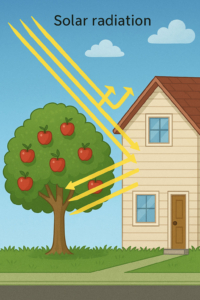 Landscape plants interact with incoming solar radiation through the processes of heat reflection and albedo, which also work to moderate urban heat. Heat reflection is likely a familiar concept, but what exactly is albedo? Albedo describes how much sunlight a surface, like a leaf, bounces off instead of being absorbed. You could think of it like a suntan (or sunburn). The more sunlight your body absorbs to tan or burn the lower your skin’s albedo. The more sunlight your body reflects, the higher your skin’s albedo.
Landscape plants interact with incoming solar radiation through the processes of heat reflection and albedo, which also work to moderate urban heat. Heat reflection is likely a familiar concept, but what exactly is albedo? Albedo describes how much sunlight a surface, like a leaf, bounces off instead of being absorbed. You could think of it like a suntan (or sunburn). The more sunlight your body absorbs to tan or burn the lower your skin’s albedo. The more sunlight your body reflects, the higher your skin’s albedo.
In landscapes, albedo varies with plant species, canopy structure, and seasonal dynamics. For example, deciduous trees typically have higher albedo because of their (generally) lighter leaf colors, while coniferous trees typically have lower due to their darker leaves and denser canopies (Betts & Ball, 1997). Conversely, open grasslands or agricultural crops may have higher albedos because they reflect more solar radiation.
Plant canopy structure and leaf orientation also influence how much sunlight is reflected or absorbed. Denser plant canopies tend to absorb more solar energy, while lighter-colored or waxy leaves tend to reflect more solar energy. Seasonal changes like leaf drop in the fall and leaf emergence also effect albedo (Verstraete, 1987).
Conclusion
Landscape plants help cool the environment through a combination of shading, evaporation, and transpiration, though the extent of cooling provided depends on the plant, the local climate, and how the plants interact with the surrounding built environment. Heat reflection by landscape plants and albedo also influence cooling.
Some strategies to increase the cooling provided by landscape plants in urban settings include design-based strategies that focus on plant selection, arrangement, and integration into urban landscapes to maximize shading, evapotranspiration, and heat reflection (Shashua-Bar et al., 2009). These strategies can include increasing tree canopy cover (McPherson, 1994), installing green roofs and walls (Wong et al., 2003), selecting plants with higher reflectivity (Ridgwell et al., 2009), and using high albedo mulches (Carvalho et al., 2021).
By thoughtfully designing urban landscapes with cooling in mind, we can create more comfortable and livable cities while improving environmental resilience in the face of rising temperatures. Integrating trees, shrubs, grasses, and other plant materials into urban planning processes can significantly reduce surface and air temperatures, enhance biodiversity, and even improve public health outcomes.
These green infrastructure solutions are not just beautiful—they are vital tools in the climate adaptation toolkit. As cities continue to grow and heat increases become more common plant-powered cooling strategies offer effective and environmentally responsible solutions for the future.
References
Betts, A.K. and J.H. Ball. 1997. Albedo over the boreal forest. Journal of Geophysical Research: Atmospheres 102:28901-28909.
Braun, R.C., P. Mandal, E. Nwachukwu, and A. Stanton. 2024. The role of turfgrasses in environmental protection and their benefits to humans: Thirty years later. Crop Science 64: 2909-2944.
Carvalho, H.D.R., B. Chang, K.J. McInnes, J.L. Heilman, B. Wherley, and J.A. Aitkenhead-Peterson. 2021. Energy balance and temperature regime of different materials used in urban landscaping. Urban Climate 37:100854.
Carvalho, D.F., L.M.M. Oliveira and E.F. Coelho. 2021. Effect of ground covers on soil temperature in urban and rural areas. Environmental Monitoring and Assessment 193:456.
Dooley, E.C. 2022. Could vines be the answer to speeding urban cooling, water reduction in the West? College of Agricultural and Environmental Sciences, University of California, Davis. https://caes.ucdavis.edu/news/could-vines-be-answer-speeding-urban-cooling-water-reduction-west.
Erell, E. and T. Williamson. 2006. Simulating air temperature in an urban street canyon
in all weather conditions using measured data from a reference meteorological
station. International Journal of Climatology 26:1671-1694.
Kenward, A., D. Yawitz, T. Sanford and R. Wang. 2014. Summer in the City: Hot and Getting Hotter. Climate Central. Princeton, NJ.
McPherson, E.G. 1994. Cooling urban heat islands with sustainable landscapes. In: Platt, R.H., R. Rowntree and P.C. Muick (Eds.). The Ecological City: Preserving and Restoring Urban Biodiversity. Pp. 151-171. University of Massachusetts Press. Amherst, MA.
Oke, T.R. 1982. The energetic basis of the urban heat island. Quarterly Journal of the Royal Meteorological Society 108(455):1-24.
Pearlmutter, D., P. Berliner and E. Shaviv. 2006. Physical modeling of the pedestrian
energy exchange within the urban canopy. Building and Environment 41:783-795.
Ridgwell, A., J.S. Singarayer, A.M. Hetherington and P.J. Valdes. 2009. Tackling regional climate change by leaf albedo bio-geoengineering. Current Biology 19(2): 146-150.
Shashua-Bar, L., D. Pearlmutter and E. Erell. 2009. The cooling efficiency of urban landscape strategies. Landscape and Urban Planning 92:179-186.
Spronken-Smith, R., T.R. Oke and W.P. Lowry. 2000. Advection and the surface energy
balance across an irrigated urban park. International Journal of Climatology 20:1033-1047.
U.S. Environmental Protection Agency. 2008. Reducing urban heat islands: Compendium of strategies. Draft. https://www.epa.gov/heat-islands/heat-island-compendium.
Verstraete, M.M. 1987. Radiation transfer in plant canopies: Transmission of direct solar radiation and the role of leaf orientation. Journal of Geophysical Research: Atmospheres 92:10985-10995.
Wong, N.H., Y. Chen, C.L. Ong and A. Sia. 2003. Investigation of thermal benefits of rooftop garden in the tropical environment. Building and Environment 38(2):261-270.
Zhang, R. 2020. Cooling effect and control factors of common shrubs on the urban heat island effect in a southern city in China. Scientific Reports 10, Article number: 17317.



